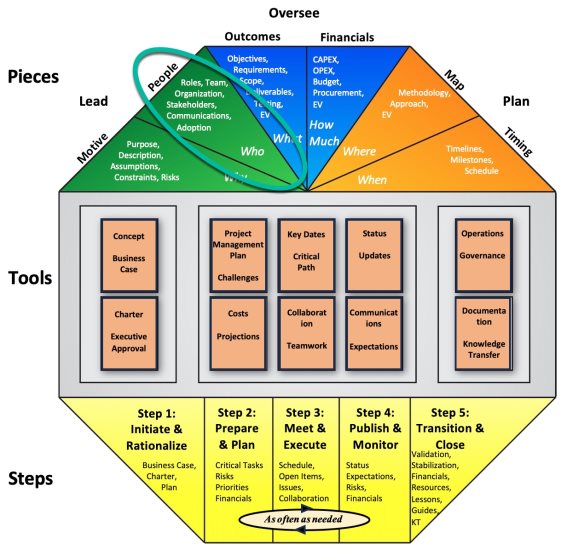How to Work with the 3 Types of Stakeholders on Your Project
The purpose of this article is to cover important considerations when working with different types of stakeholders to engage with them most effectively for your project’s success.
Stakeholders is one of the project pieces under the People segment within the LEAD domain in the MPM model.

Stakeholders is one of the project pieces under the People segment within the LEAD domain in the MPM model
How to work with Stakeholders
Internal Stakeholders
Stakeholders who are project team members are part of your team and so you are communicating with them daily or weekly. Let’s hope you are.
There are other articles, suggestions, and tips on building and leading highly effective teams under the Simple PM Strategies site Learning Hub, based on over 40+ projects in 30+ different client environments.
If you do it right, you can create a team that follows you down the darkest alleys and to the farthest corners of the globe to find the best solutions. Working with this team has a lot of challenges and rewards, but it involves personal, frequent communications covered in other articles under the heading of “Leading the Team.”
External Stakeholders
These stakeholders need periodic communication in accordance with the agreed upon schedule in the communications plan.
It is a two-way communication, but usually formal and spelled out in the communications plan.
Key Stakeholders
Key stakeholders are those who are part of your steering committee and you really lean on them to develop your charter.
Ask your Key Stakeholders to be on your Steering Committee.

Your key stakeholders have your back
Make sure you have Stakeholder representation from different levels in the organization to ensure you have different perspectives.
Obviously, this doesn’t apply if it is your own small company, but below is a suggestion:
- Someone as close to an executive as possible
- Your direct manager
- A business manager whose team has a high impact from the outcomes of your project.
- Someone from Finance
Try to aim for between three and six people, in case some are unavailable at certain times. You facilitate, chair the meeting and take minutes.
Sometimes you can have had someone doing the minutes for you, and that is nice, but often you are probably the one wearing all hats. If you keep the group small, that should be doable for you.
Know what your Stakeholders are Looking for
There are some questions that your key stakeholders have, or should have, that they may not ask, but you need to make sure between the two of you, they get answered or it will come back to bite you.
What does success mean for this project, and how is that measured?
- Make sure they understand and agree with the objectives and how they are being measured.
- Even if after the project starts, they want to alter the measures of success, do that at a steering meeting, and get everyone’s agreement and then add to the minutes of the steering meeting and circulate with a “silence means consent” intent.
What can prevent this project from being successful?
- Make sure they understand and agree with the risks.
- Walk through any Risk Mitigations you have defined and get their feedback whether the steps are realistic and doable.
- Update or add risks based on their feedback.
How are they receiving project communications?
- Show them the communication plan and where they fit.
- Confirm the frequency and kind of communication you are providing to them for the project.

Confirm the frequency and kind of communication for Stakeholders
How are their interests being met on this project?
- This is a tricky one, because the requests can seem personal, however make sure any assumptions they have about what the project is producing are represented in the Objectives, Scope, Requirements, or Deliverables.
- The point is to make sure both your expectations and those of your stakeholders are aligned for the success of the project.
Align with Stakeholders
How do achieve the answers to these questions? How do you align with them?
Your project team you work with every day, so that is a different kettle of fish.
For External Stakeholders you can speak with them personally or do a formal verbal or email survey to get the answers. Keeping it formal is the best approach for external stakeholders.
However, for Key Stakeholders, the you can usually handle this as a stakeholder meeting, either physical or by conference call, and walk through the charter or whatever update is required. Then everyone is present and walking through everything at once together and this naturally facilitates covering all of the necessary questions.
It saves time covering it in a general meeting as well because everyone is present. It may take you several meetings due to the changes that come out of each session. There are some steps for this in the article on Steering Committee Launch.
Summary
Stakeholders are very critical to the success of your project, and it is important to understand the roles each plays in your project’s outcomes.
If you support them, meaning you make sure you keep them informed and aware, they are going to have your back, especially when others are questioning the validity of your project.
Make sure at the outset, you are aligned on what success means for your project and how to measure it, what the risks are that can prevent the project from being successful, how they are receiving communications, and how their interests are being met.
Action Steps / Apply This Knowledge
- Review your list of current external stakeholders and ensure you can confidently answer the questions the way they would answer them. Working with Key Stakeholders is covered in this article.
- If the answer to 1 above is no, then circulate a communication to each individual key external stakeholder to get their answers to the questions.
- Update the charter and circulate to your Key Stakeholders to before publishing to ensure they are in agreement. You may need a meeting or call to confirm that. Then republish your charter and you’re back on track with your project. Then communicate with your external stakeholders as per your communications plan.
- Prompt engineering guidance for AI GPTs such as chatGPT: “I’m a business leader leading a project whose purpose is Y, and delivering X. What are some important considerations when working with different types of stakeholders to engage with them most effectively for my project’s success?”
Learn More to Do More
Business evolves through change initiatives otherwise known as projects. The key to managing these change initiatives so you have more time, and less stress is to use simple strategies and tools.
Check out the Learning Hub’s other Articles with Actionable Steps, organized with a busy leader in mind, by topic or main idea, and with some AI GPT (e.g. ChatGPT) prompt engineering suggestions under the Action steps: https://simplepmstrategies.com/learning-hub-index
LEAD Working with Stakeholders
© Simple PM Strategies 2024
